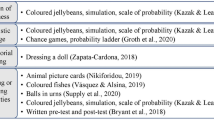Abstract
This paper presents the application of decision-theoretic technique to computer-based tutoring system for elementary mechanics. The technique uses sound probabilistic reasoning and a student model to identify learner's misconception(s). Bayesian belief networks are the building blocks of the student model. The probability values in Bayes' nets are provided by teacher and are based on her judgement, but may be substituted with actual statistics. Evidence on student's mastery of concepts is obtained through her responses to appropriately selected items. Subsequently, Rasch one-parameter model is used to calibrate the item and person parameters (also known as difficulty and ability indices, respectively). The system is able to provide teacher with information for fine-tuning her pedagogical instructions and guide her in coaching students. It is also able to provide students with immediate feedback to improve their proficiencies and ultimately their grades.
Similar content being viewed by others
REFERENCES
Adams, R. J., Wilson, M., and Wang, W. C. (1997). The Multidimensional Random Coefficients Multinomial Logit Model, Applied Psychological Measurement 21: 1–123.
Castillo, E.,Gutié rrez, J. M., and Hadi, A. S. (1997). Expert Systems and Probabilistic Network Models, Springer-Verlag, New York.
Charniak, E. (1991). Bayesian Networks Without Tears. AI Magazine 12: 50–63.
Collins, J. A., Greer, J. E., and Huang, S. X. (1996). Adaptive Assessment Using Granularity Hierarchies and Bayesian Nets. In Frasson, C., Gauthier, G., and Lesgold, A. (Eds.), Intelligent Tutoring Systems, Third International Conference, ITS'96, Springer-Verlag, New York, pp. 569–577.
Fisher, G. H., and Molenaar, I. W. (1995). Rasch Models: Foundations, Recent Developments, and Applications, Springer-Verlag, New York.
Gü rer, D. W., and Ota, P. T. (1995). Representing Mathematical Problem Solving Episodes with an Evolving student Model. In Greer J. (Ed.), Artificial Intelligence in Education, Association for the Advancement of Computing in Education, Washington, DC, pp. 178–185.
Hambleton, R. K., and Swaminathan, H. (1996). Item Response Theory: Principles and Applications, Kluwer Nijhoff Publishing, Boston.
Holt, P., Dubs, S., Jones, M., and Greer, J. E. (1994). The State of Student Modeling. In Student Modeling: the Key to Individualised Knowledge-based Instruction, NATO ASI Series, Vol. 125, Springer-Verlag, New York, pp. 3–35.
Lincre, J. M., and Wright B. D. (1998). WINSTEPSRasch Measurement, MESA Press, Chicago.
Litwin, P., Getz, K., and Gilbert, M. (1997). Access 97 Developer's Handbook, 3rd ed. Sybex Inc., California.
Mislevy, R. J. (1995). Probability-based Inference in Cognitive Diagnosis. In Nichols, P. D., Chipman, S. F., and Brennen, R. L. (Eds.), Cognitively Diagnostic Assessment, Lawrence Erlbaum Associates, Hillsdale, NJ, pp. 43–72.
Norsys (1999). Netica API Programmer's Library Reference Manual, Version 1.06, Norsys Software Corp.
Parry, T., and Gregory, G. (1998). Designing Brain Compatible Learning, SkyLight Training and Publishing, Arlington Heights, IL.
Pearl, J. (1988). Probabilistic Reasoning in Intelligence Systems: Networks of Plausible Inference, Morgan Kaufmann, California.
Petrushin, V., Sinitsa, K., and Zherdienko V. (1995). Probabilistic Approach to Adaptive Students' Knowledge Assessment: Methodology and Experiment. In Greer, J. (Ed.), Artificial Intelligence in Education, Association for the Advancement of Computing in Education, Washington, DC, pp. 51–58.
Raiffa, H. (1968). Decision Analysis, Addison-Wesley, Menlo Park, CA.
Reckase, M. D., and McKinley, R. L. (1991). The discriminating power of items that measure more than one dimension. Applied Psychological Measurement 14: 361–373.
Reiter, R. (1987). Nonmonotonic reasoning. In Annual Review of Computer Science, vol. 2, Annual Reviews Inc., Palo Alto, California, pp. 147–86.
Ross, S. (1998). A First Course in Probability, 5th ed., Prentice-Hall International, Upper Saddle River, NJ.
Russell, S. J., and Norvig, P. (1995). Artificial Intelligence: A Modern Approach, Prentice Hall, Englewood Cliffs, NJ.
Tatsuoka, K. K. (1995) Architecture of Knowledge Structures and Cognitive Diagnosis: A Statistical Pattern Recognition and Classification Approach. In Nichols, P. D., Chipman, S. F., and Brennan, R. L. (Eds.), Cognitively Diagnostic Assessment, Lawrence Erlbaum Associates, Hillsdale, NJ, pp. 327–360.
TCI Software Research. (1998). Scientific Notebook Version 3.00 Build 939, Brooks/Cole Publishing Company, New Mexico.
VanLehn, K., and Martin, J. (1998). Evaluation of an Assessment System based on Bayesian Student Modeling. International Journal of Artificial Intelligence and Education 8: p. 2.
Author information
Authors and Affiliations
Rights and permissions
About this article
Cite this article
Pek, PK., Poh, KL. Framework of a Decision-Theoretic Tutoring System for Learning of Mechanics. Journal of Science Education and Technology 9, 343–356 (2000). https://doi.org/10.1023/A:1009484526286
Issue Date:
DOI: https://doi.org/10.1023/A:1009484526286




